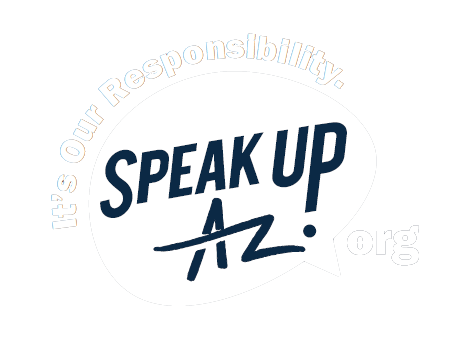"Can You Hear Me Now?"
How speech technology helps individuals communicate
The interpretation of a well-known advertising slogan, “Can you hear me now?” is more meaningful if you struggle to speak so that others can understand you. Some individuals with a developmental disability are inherently nonverbal because an accompanying impairment makes the ability to speak physically impossible. This is where alternative and augmentative communications (AAC) come in. The American Speech-Language-Hearing Association explains: “AAC is augmentative when used to supplement existing speech, and alternative when used in place of speech that is absent or not functional.”
The DES Division of Developmental Disabilities (DDD) contracts with Advanced Therapy Solutions (ATS), among other vendors, to provide physical, occupational and speech therapies. In honor of AAC Awareness Month in October, a speech pathologist and three families who are members of DDD, share their personal experiences to help tell how important it is for an individual to express their wants and needs, emotions, and ideas.
Brenda Del Monte, MA, CCC-SLP
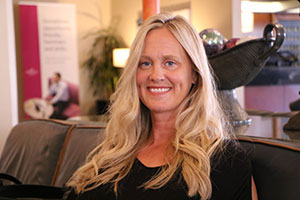
Brenda Del Monte, certified speech-language pathologist with Advanced Therapy Solutions, evaluates and trains DDD members who have a medical need for augmentative or alternative communications assistance.
Brenda Del Monte, a certified speech-language pathologist with ATS, evaluates and trains DDD members who would benefit from a communication device. She explains the process below.
“First of all, you have to figure out, ‘How’s the child going to access the communication device?’ Is it going to be through their hands; is it going to be through their eyes; and if none of those work, do they have another voluntary movement in their body that they can [use to] access a switch? [Next,] I try to match, ‘How does this child store language in their brain [to determine which language system to use]?’” For example, would “semantic compaction” (which represents language through icons) work, or would a device that uses predictive language (which is similar to the autocorrect feature in word processing software) be better? Once the access method and language system are determined, Del Monte has the member try three different devices to see which one works best for the individual.
Bella
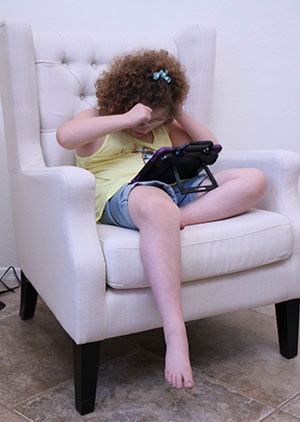
Bella Gellman, nine years old, uses her AAC device that speaks on her behalf.
Nine-year-old Isabella (Bella) has been a DDD member since she left the neonatal intensive care unit as an infant. Born with Prader-Willi syndrome (a genetic disorder that can affect appetite, growth, metabolism, cognitive function and behavior), Bella understands what’s being said to her. She just isn’t able to properly verbalize her thoughts and desires at this stage in her development.
“She was on an NG [nasogastric] tube for the first two and a half years of her life, so she couldn’t develop [language skills],” explained Bella’s mom, Robin Gellman. Before AAC, Bella and her family would become extremely frustrated with the inability to communicate.
Del Monte commented, “There’s just the entire quality of life [aspect]; of being a social being. What we find is that these kids that are late to develop verbal speech will develop behaviors to get your attention. Often that becomes a negative behavior because it’s very frustrating for them.” There were times when something angered Bella and her only recourse was to exhibit behaviors.
“It’s really a lot of frustration on both sides because when we don’t know what she wants … she’s getting madder and madder, and we’re upset because she’s upset,” said Gellman. “It’s just not good for anybody.”
Bella started using a “direct-select” communication device at the age of three. According to All About AAC, there are two selection methods: “direct selection and indirect selection (scanning). With a direct selection device, the user points or taps a symbol, picture or object using a body part, such as a finger, hand or eye gaze, or they can use an adapted tool, such as a laser pointer.” Bella uses her finger to directly select the buttons on a touch-screen pad that represent the words she wants to say, then the speech-generating device talks for her.
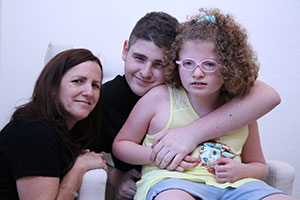
Robin Gellman, son Adrian and daughter Bella pause for an informal portrait.
“We started off with just a couple of buttons,” said Gellman. “As her vocabulary expanded, we got bigger and bigger. It started off with 2, then 4, now she’s at a 60-button [level].” Not only does the device help Bella communicate with her family, it enables her to be social with her classmates.
“I think it’s also helping her learn language. When I say language, I mean from an academic standpoint. Her device uses both pictures and words.” When Bella becomes familiar enough with a word, Gellman removes the accompanying picture.
Del Monte affirmed that a device helps a child learn sentence structure. Using the device, a child can say, “I want,” “play,” “bubbles.” The device voices the message “I want … to play … bubbles.”
“She’s come a long way,” said Gellman, “a really long way.”
Lauren
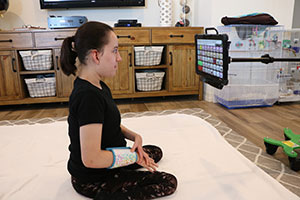
Soon to be 18 years old, Lauren Potter demonstrates how she uses an eye gaze AAC device to help her communicate.
Lauren also uses a direct select communications device, but because of physical limitations, her device is operated with eye-gaze technology. A spunky 16-year old, Lauren is smart, funny and understands everything you say. She’s just unable to verbalize on her own because of Rett syndrome, a rare genetic neurological disorder that causes severe physical impairments. But with AAC, she can use her eyes to navigate through pages on the device until she finds the words she wants to say. Each screen can represent a category, such as “food” or “body,” and displays up to 45 icons. There are phrases, such as “I need” or “I’m finished,” that are available to her on each screen. It can take multiple screens for her to vocalize exactly what she wants to express. Kelly Potter, Lauren’s mother, gave this anecdote of how Lauren named her new puppy.
“I programmed in a page with a bunch of dog names,” said Potter. “’I like’ and ‘I don’t like.’” We worked on it for about a week. My sister and I were sitting here [at the kitchen table] talking and [Lauren] was in between us on the floor. I had [the list] down to three or four names. All of a sudden, [Lauren] hit, ‘My new dog’s name is going to be Chloe.’ She had to hit four different screens to get that and the device just automatically said it.”
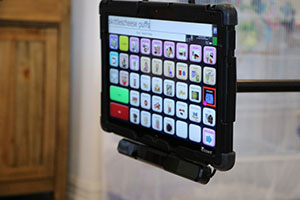
One page from Lauren’s AAC tablet shows the number of “buttons” that she can use to assist her in speaking.
In addition to Rett syndrome, Lauren has apraxia and is prone to seizures. The AAC is extremely helpful when Lauren needs to communicate how she’s feeling. For some individuals like Lauren, the ability to communicate their medical needs is crucial. Del Monte explained, “There’s some astronomical statistic about the number of children that end up in the hospital that are nonverbal because we are only treating a child’s medical need when [physical symptoms are] visible. [A child] saying, ’My head hurts,’ and mom getting her started on cold medicine to get a good night’s sleep, they’re curbing that and they’re having way less hospital stays now than they did before.”
Lauren’s state of health is the biggest issue that concerns Potter. “One thing that has been huge for us, whenever she’s sick or not feeling good, she’s never been able to tell us what’s wrong,” explained Potter. “[Now] she can tell us when something hurts [such as her throat, stomach or arm].” This is especially important because some health issues, if left untreated, can trigger seizures.
With AAC, Lauren can also relay when she’s had enough. “She’s gotten really good at the ‘I’m finished’ and ‘I’m done’ … Otherwise, some people who don’t know - they’ll just kind of push and that can send her into a seizure, too. Being able to communicate that, I think has been huge.”
Potter describes her daughter as similar to most teenagers. “She can learn. She’s smart. She’s in there. She has opinions. She’s a teenager – I get the eye rolls,” said Potter with a smile.
Houston
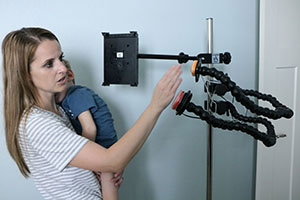
Chelsea Blair demonstrates the switches that her son, Houston, uses to help him communicate.
According to All About AAC, the indirect selection method is more difficult to use and more physically demanding. An indirect selection device is what three-year-old Houston is learning to operate. Because of cerebral palsy, seizures and vision impairment, Houston is unable to find items on a screen or use his fingers or eyes to navigate through screens. Instead, his AAC device is operated by switches and an iPad mounted to a pole. When he’s sitting in his chair, Houston uses his head to tap a switch to scan his options then lifts his left arm to hit a proximity switch to select the words he wants.
“It’s going really well,” said Houston’s mother, Chelsea Blair. “I think he likes being able to communicate, to make choices.”
Houston attends preschool and takes his AAC device with him. The teachers at the preschool have a list of a lot of core words they are helping him to learn. His device also includes a page to communicate emotions. “I’m happy, I’m sad, I’m tired, I don’t feel good, I need a diaper change,” explained Blair. “Were still getting him used to how to use the device and how to find that page and to tell us.”
The same types of switches used to operate the AAC also help Houston to move with the aid of a power chair. “He’s learning how to use the power chair using switches,” said Blair. “With the power chair, he turns with his head, then [can] go straight to what he wants.” Earlier this year, Houston participated in his first derby, an annual event hosted by the nonprofit Believe Beyond Ability, where children with multiple disabilities drive specially adapted Power Wheels vehicles.
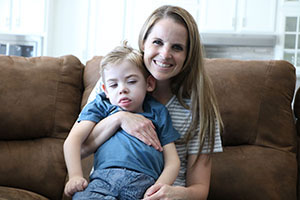
Holding her son, Houston, Chelsea Blair takes a moment for a quick photo.
“He was brand new at switches and he was actually still in a brace [while recovering from hip surgery] but we let him come out of the brace for a little bit each day. So, we let him out of the brace to go to the derby. He would hit the switch with his head and go.”
Because of the hip surgery, Houston’s progress “took a couple steps back” but he’s working hard to catch up. Blair confirmed that all the therapies Houston receives – speech, occupational and physical therapies – take “a lot of time” but she is an advocate for her son and advises other families to take “advantage of the therapies that are offered [through DDD] because they are tremendous and they truly will help.”
“Just know that [your special-needs child] can achieve so much if we just help them learn, help them make those connections in their brain, help [them] develop.” As for Houston, “He’s such a blessing to me and our family. I love him. He goes with me everywhere I go. He’s amazing and he’s wonderful and I’m really proud to be his mom.”
By Lyn Riley

